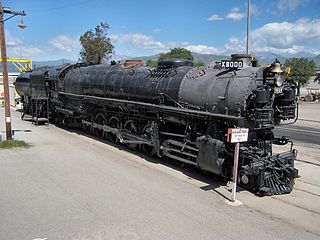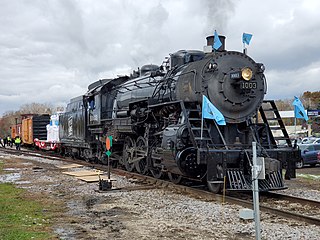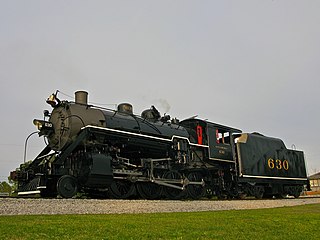
A Mallet locomotive is a type of compound articulated steam locomotive, invented by the Swiss engineer Anatole Mallet (1837–1919).

The American Locomotive Company was an American manufacturer that operated from 1901 to 1969, initially specializing in the production of locomotives but later diversifying and fabricating at various times diesel generators, automobiles, steel, tanks, munitions, oil-production equipment, as well as heat exchangers for nuclear power plants.

The Union Pacific Big Boy is a type of simple articulated 4-8-8-4 steam locomotive manufactured by the American Locomotive Company (ALCO) between 1941 and 1944 and operated by the Union Pacific Railroad in revenue service until 1962.
Under the Whyte notation for the classification of steam locomotives, 2-10-2 represents the wheel arrangement of two leading wheels, ten powered and coupled driving wheels, and two trailing wheels. In the United States and elsewhere the 2-10-2 is known as the Santa Fe type, after the Atchison, Topeka and Santa Fe Railway that first used the type in 1903.

In the Whyte notation for classifying steam locomotives by wheel arrangement, a 4-6-6-4 is a railroad steam locomotive that has four leading wheels followed by two sets of six coupled driving wheels and four trailing wheels. 4-6-6-4's are commonly known as Challengers.

The Union Pacific Railroad 9000 Class was a class of 88 steam locomotives, built by ALCO for the Union Pacific between 1926 and 1930.

Soo Line 1003 is a class "L-1" 2-8-2 "Mikado" type steam locomotive built by the American Locomotive Company (ALCO) in March 1913 as a member of the Minneapolis, St. Paul and Sault Ste. Marie Railroad L-1 class. It was retired from regular revenue service in August 1959 and restored to operating condition on October 27, 1996. Today, it is occasionally operated on the major railroads of the American Upper Midwest.

Union Pacific 844 is a class "FEF-3" 4-8-4 "Northern" type steam locomotive owned and operated by the Union Pacific Railroad for its heritage fleet. Built in December 1944 by the American Locomotive Company (ALCO) of Schenectady, New York, No. 844 is one of four surviving FEF series locomotives and the only one in operation.

Union Pacific 3985 is a four-cylinder simple articulated 4-6-6-4 "Challenger"-type steam locomotive built in July 1943 by the American Locomotive Company (ALCO) of Schenectady, New York, for the Union Pacific Railroad. No. 3985 is one of only two Challengers still in existence and the only one to have operated in excursion service.

Union Pacific 6936 is an EMD DDA40X locomotive built for the Union Pacific Railroad (UP). Previously a part of UP's heritage fleet, 6936 was for several decades the last remaining operational "Centennial" type, and thus the largest operational diesel-electric locomotive in the world. It is now owned by the Railroading Heritage of Midwest America in Silvis, Illinois, who plans to return the locomotive to operation.

An excursion train is a chartered train run for a special event or purpose. Examples are trains to major sporting event, trains run for railfans or tourists, and special trains operated by the railway company for employees and prominent customers.

Southern Pacific 2472 is a P-8 Class 4-6-2 heavy "Pacific" type steam locomotive built by the Baldwin Locomotive Works for Southern Pacific Railroad (SP) in 1921. No. 2472 is one of three surviving Southern Pacific P-8 class 4-6-2 Pacific locomotives, the other two bring Nos. 2467 and 2479. The 4-6-2 designation means it has four leading wheels, six driving wheels, and two trailing wheels. The locomotive was used by the Southern Pacific Railroad to haul passenger trains until being retired in 1957. The locomotive was then donated to San Mateo County and placed on static display at the San Mateo County Fairgrounds. After being restored to operational condition in the early 1990s, the locomotive would pull excursion trains on the Niles Canyon Railway until being retired in 2015. The No. 2472 was then moved to the Northwest Pacific Railroad, where it is as of 2023, undergoing its Federal Railroad Administration (FRA) mandated 1,472 day inspection and overhaul.

The Union Pacific FEF series consists of 45 4-8-4 "Northern" steam locomotives built by the American Locomotive Company (ALCO) between 1937 and 1944 and operated by the Union Pacific Railroad until 1959.

Southern Railway 630 is a 2-8-0 "Consolidation" type steam locomotive built in February 1904 by the American Locomotive Company (ALCO) of Richmond, Virginia for the Southern Railway as a member of the Ks-1 class. It is currently owned and operated by the Tennessee Valley Railroad Museum (TVRM) in Chattanooga, Tennessee where it resides today for use on excursion trains.

Union Pacific 4014 is a steam locomotive owned and operated by the Union Pacific (UP) as part of its heritage fleet. It is a four-cylinder simple articulated 4-8-8-4 "Big Boy" type built in 1941 by the American Locomotive Company (ALCO) at its Schenectady Locomotive Works. It was assigned to haul heavy freight trains in the Wasatch mountain range. The locomotive was retired from revenue service in 1959 and was donated to the Railway & Locomotive Historical Society; thereafter, it was displayed in Fairplex at the RailGiants Train Museum in Pomona, California.

Chesapeake and Ohio Railway 2716 is a class "K-4" 2-8-4 "Kanawha" (Berkshire) type steam locomotive built in 1943 by the American Locomotive Company (ALCO) for the Chesapeake and Ohio Railway (C&O). While most railroads referred to these 2-8-4 type locomotives as Berkshires, the C&O referred to them as Kanawhas after the Kanawha River, which flows through West Virginia. Used as a dual service locomotive, No. 2716 and its classmates served the C&O in a variety of duties until being retired from revenue service in 1956.

The history of the Union Pacific Railroad stretches from 1862 to the present. For operations of the current railroad, see Union Pacific Railroad; for the holding company that owns the current railroad, see Union Pacific Corporation.
The Union Pacific heritage fleet includes commemorative and historic equipment owned by the Union Pacific Railroad. The fleet currently consists of two historic steam locomotives, three historic diesel locomotives, seventeen modern diesel locomotives in historic or commemorative paint schemes and nearly four dozen passenger cars used on office car specials and excursion trains.

Union Pacific 4023 is a 4-8-8-4 Big Boy steam locomotive preserved at Kenefick Park in South Omaha, Nebraska. Built in 1944 by the American Locomotive Company at its Schenectady Locomotive Works, No. 4023 is one of eight surviving Big Boys and the only one that is part of the class' second group built in 1944, as all seven of the other survivors were part of the first group built in 1941.

Union Pacific 5511 is a 2-10-2 “Santa Fe” type steam locomotive built by the Baldwin Locomotive Works in 1923 as part of the Union Pacific Railroad's TTT-6 class. It is the last remaining member of its class and the only remaining 2-10-2 to be operated by the Union Pacific.

















